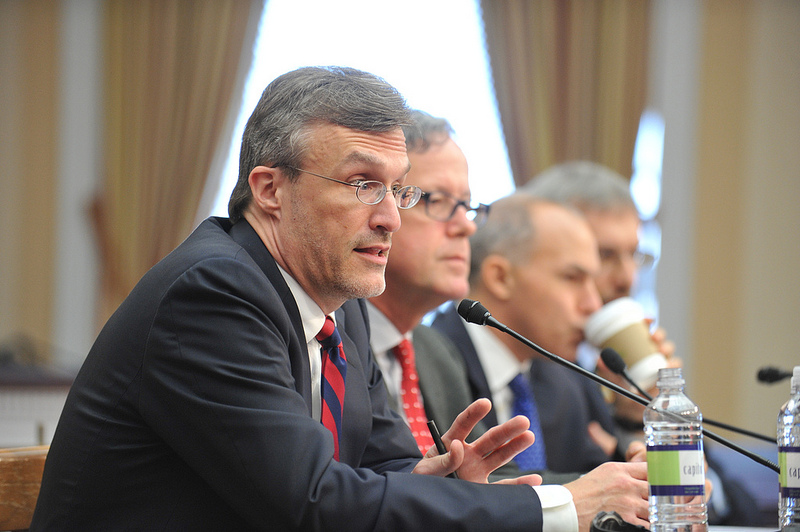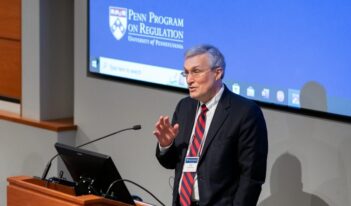
PPR holds Washington workshop showcasing latest research on employment impacts.
With unemployment coming down only slowly from its Great Recession heights, political debate over the potential impact of regulations on job growth rages on in Washington, D.C.
In an effort to infuse policy debate with the findings of social science research, the Penn Program on Regulation (PPR) held a workshop earlier this fall to examine the impacts of regulation on employment. The workshop, which took place on Capitol Hill, in the Rayburn House Office Building, featured presentations by leading economists, policy analysts, and legal scholars, many of whom are contributors to the forthcoming PPR book, Does Regulation Kill Jobs? (University of Pennsylvania Press).
PPR’s Capitol Hill workshop revealed the complexity—and some of the empirical surprises – lurking behind the simple claims about regulation that have proliferated throughout contemporary political debate. Notwithstanding economic theory that might predict regulations would result in negative impacts on employment – not to mention numerous anecdotes about employers shutting down or laying off workers – systematic empirical studies have yet to produce any clear confirmation that regulation truly kills jobs.
“Although the phrase ‘job-killing regulations’ may fit well on a bumper sticker, regulations also shift jobs and can create new ones too,” said Cary Coglianese, Director of PPR, who organized and moderated the workshop. “The weight of the evidence is that regulation is not a significant factor affecting overall employment levels in the United States,” he added.
The speakers on the workshop’s first panel focused on the state of economic research on the link between jobs and regulation. Joseph Aldy, Assistant Professor of Public Policy at the Harvard Kennedy School of Government, reported findings from his study of industry responses to energy price shocks, showing how the employment effects of any price increases from controls on carbon-intensive energy sources would be minimal, even in the most highly affected industries.
Keith Hall, Senior Research Fellow in the Mercatus Center at George Mason University, argued that estimates of “net” jobs lost or created are biased towards trivializing the negative effects of regulation. He asserted that the jobs often created by regulations are “compliance jobs”— such as auditor positions created to help regulated entities comply with the regulations— while the many jobs lost by regulation tend to be ones on the factory floor.
However, Timothy Bartik, Senior Economist at the W.E. Upjohn Institute, took issue with Hall’s argument, pointing to research showing that the job gains created by regulations can easily offset any job losses and still generate important social benefits, not merely from the direct benefits of the regulation, but also from indirect benefits associated with employment. A compliance job is still a job, noted Bartik.
Panelists and audience members also emphasized that regulations can create both white-collar and production jobs in industry sectors that grow in response to regulation, not just in the firms required to comply.

Jonathan Masur, University of Chicago Law School; Brian Mannix, Visiting Scholar at George Washington University; Lisa Robinson, Senior Fellow, John F. Kennedy School of Government, Harvard University
The workshop’s second panel focused on the analytic challenges in improving agency practices for analyzing employment impacts when creating new regulations. Jonathan Masur, Deputy Dean and Professor of Law at the University of Chicago Law School, recounted the story of an EPA pulp and paper regulation that looked like it was clearly net-beneficial but whose costs would outweigh its benefits if estimates of the effects of predicted layoffs were included in the agency’s cost-benefit analysis. Masur argued that agencies would do well to incorporate monetary estimates of the impacts on employment when they analyze new regulations.
Brian Mannix, a visiting scholar at George Washington University, cautioned against agencies incorporating employment effects in their calculation of a proposed rule’s net benefits. These effects, he argued, are already factored into the marketplace and effectively included already in standard cost-benefit analyses. Making separate calculations of the indirect effects of a rule on employment could amount to double-counting them, he suggested.
If agencies do more to incorporate unemployment costs in their cost-benefit analyses, they must attempt to measure the full range of effects associated with job loss, as well as the uncertainties in those effects, argued Adam Finkel, Senior Fellow and Executive Director of the Penn Program on Regulation. He advised caution in relying too much on simple proxy metrics like “compliance costs” to drive economic and job-loss analyses. But, overall, he was optimistic about the potential for economists to replicate in their analysis of employment effects some of the successes his field of quantitative risk assessment has had in tackling other difficult analytic problems.
With many of the workshop speakers agreeing that, as a matter of “good government,” agencies should attempt to do better at taking account of employment effects—even if those effects are ultimately negligible when aggregated across the entire economy—Lisa Robinson, Senior Fellow at the Harvard Kennedy School of Government, turned to the task of outlining a set of “best practices” to guide agencies in this undertaking. She urged agencies to employ screening analyses to focus on areas where there are likely employment effects, to be realistic about baseline employment conditions, and to conduct impact analyses even on proposals to ameliorate any job impacts of regulations. Moreover, she encouraged agencies to design regulations so that retrospective analyses of employment effects could be more easily conducted.
Most of the expert panelists seemed to agree that the question of regulation’s impact deserves greater attention, both in academic research and in regulatory agencies’ analyses.

Adam Finkel, Senior Fellow and Executive Director, Penn Program on Regulation
“Although the empirical research fails to find much of an overall net effect of regulation on employment, this doesn’t mean that specific regulations will not at times have tangible effects on employment within specific sectors or regions,” said Coglianese. “Some individual workers and their families will be negatively impacted by job shifting induced by regulation, just as they obviously are from the everyday job-churning in a market economy.”
The complexity of the relationship between regulation and employment necessitates both careful analysis and caution in making the kinds of exaggerated claims that are frequently advanced in popular political discussion. Indeed, Adam Finkel may have summed up the workshop’s contribution best when he quoted Cass Sunstein, the former OIRA Administrator, who has stated that “the Republican claim that ‘job-killing regulation’ is a redundancy is as ridiculous as the left-wing view that ‘job-killing regulation’ is an oxymoron….Both are silly political claims that have no place in a serious discussion.”
The Penn Program on Regulation’s project on jobs and regulation – including its recent workshop in one of the halls of Congress – aims to help make policy discussion of this important policy question more evidence based and more serious.




